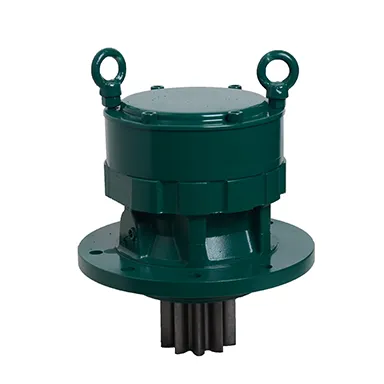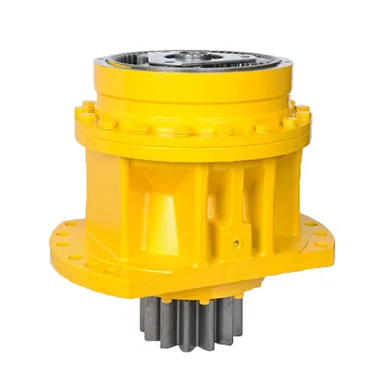
An excavator slewing drive is a mechanical device that integrates a driving source, reducer, bearing, and slewing support into one unit. It facilitates large-angle rotational motion and positioning and is widely used in various equipment requiring rotational motion. Slewing drives are critical components in a multitude of applications, providing the necessary torque and rotation for efficient operation. In the context of excavators, slewing drives enable the upper structure to rotate 360 degrees, providing flexibility and efficiency in various tasks.
The slewing drive operates by using a motor or another power source to drive gears or worm shafts, which in turn rotate the gear ring or worm wheel. This mechanism allows for the rotational movement of the attached equipment. Typically, a slewing drive comprises a housing, slewing support, driving source, and control system. The integration of these components ensures smooth and precise rotational movement, which is essential for the effective functioning of excavators and other heavy machinery.
One of the primary functions of the excavator slewing drive is to enable the upper structure of the excavator to rotate a full 360 degrees. This capability allows the excavator to perform operations in different directions without needing to move the base. The slewing function is crucial for tasks that require precise positioning and maneuvering, such as digging, lifting, and placing materials. By facilitating seamless rotation, the slewing drive enhances the versatility and efficiency of the excavator, making it an indispensable component in various construction and mining activities.
In addition to providing rotational movement, the slewing drive also has a load-bearing function. It supports the weight of the excavator’s upper structure and the loads encountered during operation. The load-bearing capacity of the slewing drive ensures that the excavator can handle heavy-duty tasks without compromising stability or performance. High-strength materials and precision manufacturing processes are employed to enhance the load-bearing capabilities of slewing drives, making them reliable and durable even in challenging working conditions.
On construction sites, excavator slewing drives are essential for various tasks such as earthmoving, foundation construction, and demolition. The ability to rotate the excavator’s upper structure allows for efficient material handling and precise operation in confined spaces. Whether it’s digging trenches, loading trucks, or placing heavy materials, the slewing drive enhances the performance and productivity of the excavator. Its robust construction and high load-bearing capacity enable it to withstand the demands of construction environments, making it a vital component in modern construction machinery.
In mining operations, excavator slewing drives play a crucial role in the extraction and transportation of minerals. The challenging terrain and heavy loads encountered in mining require equipment with exceptional durability and reliability. Slewing drives provide the necessary torque and rotational movement to navigate the tough conditions of mining sites. They enable excavators to efficiently scoop and load mineral ores, contributing to the overall productivity of mining operations. The high efficiency and low maintenance requirements of slewing drives make them a preferred choice in the mining industry.
In municipal engineering projects, excavator slewing drives are used for tasks such as road construction, pipeline installation, and urban development. Their ability to rotate the upper structure of the excavator allows for precise and efficient operation in various urban settings. Whether working on roadways, sewer systems, or landscaping projects, the slewing drive enhances the versatility and performance of the excavator. Its high efficiency and reliability ensure that municipal engineering projects are completed on time and within budget, contributing to the overall development of urban infrastructure.

One of the notable advantages of the excavator slewing drive is its high efficiency. The integrated design and precision manufacturing of slewing drives ensure smooth and efficient rotational movement, reducing energy consumption and enhancing overall performance. The high efficiency of slewing drives translates to faster operation and increased productivity, making them a valuable component in various applications. By optimizing the rotational motion, slewing drives contribute to the efficient use of resources and energy, promoting sustainable practices in construction and mining operations.
Slewing drives are known for their high reliability and durability. They are constructed using high-strength materials and advanced manufacturing techniques, ensuring that they can withstand the rigors of heavy-duty applications. The robust design and precision engineering of slewing drives minimize the risk of breakdowns and failures, providing consistent performance even in challenging conditions. The high reliability of slewing drives reduces downtime and maintenance costs, contributing to the overall efficiency and profitability of construction and mining projects.
Another significant advantage of excavator slewing drives is their low maintenance cost. The integrated design and high-quality materials used in slewing drives reduce the need for frequent maintenance and repairs. Regular lubrication and simple inspections are usually sufficient to keep the slewing drive in optimal condition. The low maintenance requirements of slewing drives make them cost-effective and convenient for operators, ensuring that the equipment remains operational and productive for extended periods. By minimizing maintenance costs, slewing drives contribute to the overall cost-efficiency of construction and mining operations.
When choosing an excavator slewing drive, it is essential to consider the specifications and dimensions of the drive to ensure compatibility with the excavator. Factors such as the diameter of the slewing ring, the height of the drive, and the mounting dimensions should be carefully evaluated. The specifications should match the requirements of the excavator to ensure proper installation and optimal performance. Accurate measurements and detailed specifications are crucial in selecting the right slewing drive, as they directly impact the efficiency and reliability of the equipment.
The load-bearing capacity of the slewing drive is another critical factor to consider when making a selection. The slewing drive must be capable of handling the weight of the excavator’s upper structure and the loads encountered during operation. Evaluating the load-bearing capacity involves assessing the maximum axial, radial, and moment loads that the drive can support. Choosing a slewing drive with adequate load-bearing capacity ensures that the excavator can perform heavy-duty tasks without compromising stability or safety. The load-bearing capacity should align with the operational demands of the excavator to ensure reliable performance.
The type of drive used in the slewing system is also an important consideration. Slewing drives can be powered by electric motors, hydraulic systems, or other types of driving sources. The choice of drive type depends on the specific requirements of the application and the operating conditions of the excavator. Electric drives are known for their precision and energy efficiency, while hydraulic drives offer high torque and power density. Selecting the appropriate drive type ensures that the slewing drive meets the performance and operational needs of the excavator, enhancing its overall efficiency and functionality.
Regular inspections are essential to ensure the optimal performance and longevity of the excavator slewing drive. Daily inspections should include checking for any signs of wear, damage, or abnormal noise in the drive components. Inspecting the mounting bolts, gears, and seals for tightness and integrity is crucial to prevent potential issues. Identifying and addressing any problems early on can prevent costly repairs and downtime. By conducting thorough daily inspections, operators can maintain the reliability and efficiency of the slewing drive, ensuring smooth and safe operation.
Proper lubrication is vital for the smooth operation and longevity of the slewing drive. Regularly applying the recommended lubricants to the gears, bearings, and other moving parts reduces friction and wear, ensuring efficient performance. Lubrication also helps protect the drive components from corrosion and contamination. In addition to lubrication, protecting the slewing drive from harsh environmental conditions is essential. Using protective covers and seals can prevent dust, dirt, and moisture from entering the drive, extending its lifespan and maintaining its performance. Following the manufacturer’s guidelines for lubrication and protection ensures the optimal operation of the slewing drive.
The market for excavator slewing drives is continually evolving, driven by technological innovations and advancements. New materials, manufacturing processes, and design improvements are enhancing the performance and reliability of slewing drives. Innovations such as lightweight materials, advanced coatings, and precision engineering are contributing to the development of more efficient and durable slewing drives. The integration of smart technologies and automation is also shaping the future of slewing drives, enabling real-time monitoring, diagnostics, and predictive maintenance. These technological trends are driving the market towards more efficient, reliable, and intelligent slewing drives.
Environmental considerations are becoming increasingly important in the development and use of slewing drives. There is a growing emphasis on sustainability and reducing the environmental impact of construction and mining operations. Slewing drives are being designed with eco-friendly materials and energy-efficient technologies to minimize their carbon footprint. The adoption of electric and hybrid drives is also contributing to the reduction of emissions and energy consumption. As environmental regulations become more stringent, the market for environmentally-friendly slewing drives is expected to grow, promoting sustainable practices in the industry.
By understanding the functions, applications, and benefits of excavator slewing drives, we can appreciate their critical role in construction and mining machinery. Selecting the right slewing drive and ensuring proper maintenance and care can significantly enhance the performance and longevity of equipment. The future of slewing drives looks promising, with ongoing technological innovations and a growing focus on environmental sustainability. Investing in high-quality slewing drives and staying abreast of market trends will contribute to the success and efficiency of construction and mining projects.